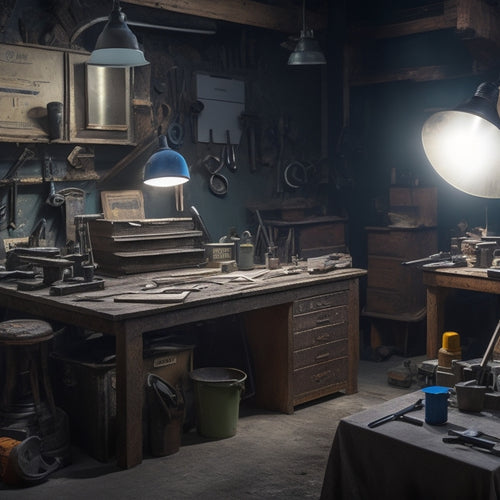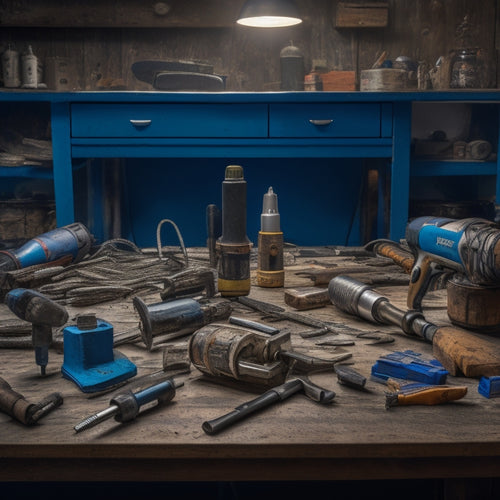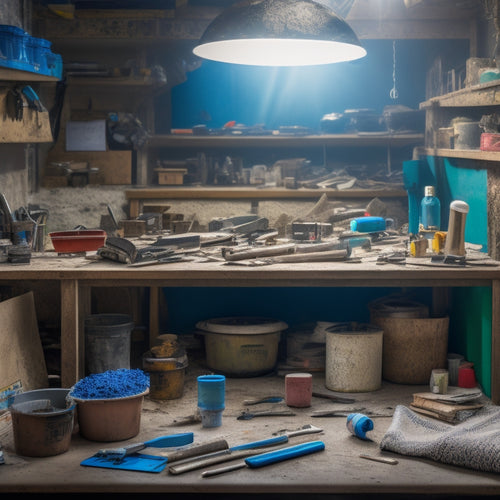
Top Concrete Finishing Tools for DIY Renovation Success
Share
To achieve DIY renovation success, you'll need a strategic arsenal of concrete finishing tools. Start with essentials like trowels, floats, and darbies for smoothening, and edge trowels for perfecting concrete edges. For texturing, consider combination scrapers, texture rakes, and stomp brushes to achieve the desired finish. Choose the right trowels and floats for your project, and don't forget must-haves like edgers, jointers, and finishing blades. Finally, learn how to achieve a polished finish by following a precise polishing sequence and applying the right sealers. As you master these tools and techniques, you'll reveal more complex finishes and take your DIY project to the next level.
Key Takeaways
• For a smooth finish, essential tools include a trowel, float, darby, edger, and concrete rake/scraper for removing excess material and texturing surfaces.
• Perfect edges are achieved with an edge trowel, which shapes and smooths concrete for seamless joints, and requires understanding of concrete manipulation.
• Texture tools like combination scrapers, texture rakes, and stomp brushes create varying textures, from smooth to rough, adding visual interest to concrete surfaces.
• Expert-recommended trowels and floats, such as steel, aluminum, and fiber-reinforced trowels, and resin or magnesium floats, ensure high-quality finishes.
• For a polished finish, surface preparation, polishing sequence, and techniques, including wet, dry, or combination methods, are crucial, followed by applying concrete sealer or wax.
Essential Tools for Smoothening
To achieve a smooth, even finish, you'll need to stock up on the essential tools for smoothening, which play a critical role in eliminating imperfections and creating a polished surface.
These tools are crucial for effective surface preparation, allowing you to apply various smoothing techniques to achieve the desired outcome.
You'll need a trowel for spreading and leveling the concrete, as well as a float to remove excess material and create a smooth surface.
A darby, a long, flat tool, helps to flatten and smooth out the concrete, while an edger is used to create a clean, defined edge.
Additionally, a concrete rake or scraper is necessary for removing excess material and achieving the desired texture.
Perfecting Concrete Edges Easily
When you're perfecting concrete edges, you'll need to master a few key techniques to achieve a professional finish.
You'll start by using an edge trowel to shape and smooth the concrete, employing techniques that guarantee a seamless joint.
Next, you'll focus on profiling concrete curves, which requires a deep understanding of how to manipulate the concrete to achieve the desired shape.
Edge Trowel Techniques
Mastering edge trowel techniques is essential for achieving professional-looking concrete edges that elevate the overall aesthetic of your DIY renovation project.
To get started, you'll need to choose the right edge trowel type for your project. There are two main types: stainless steel and resin-based. Stainless steel edge trowels are ideal for creating sharp, clean edges, while resin-based trowels are better suited for curved or irregular edges.
Proper edge trowel maintenance is also vital for achieving best results. Regularly clean your trowel with a wire brush to remove any dried concrete or debris. You should also apply a rust-inhibiting coating to prevent corrosion.
When using your edge trowel, hold it at a 45-degree angle and apply gentle to moderate pressure, depending on the desired edge profile. Use long, smooth strokes to create a uniform edge, and avoid applying too much pressure, which can cause unevenness or damage to the concrete.
Profiling Concrete Curves
You're ready to move beyond straight edges and tackle the more complex task of profiling concrete curves, where a subtle blend of art and technique is required to create smooth, flowing lines that elevate your DIY renovation project.
To master curve shaping, you'll need to invest in a few specialized tools. A concrete edger or profiler is essential for creating precise, curved edges. This tool allows you to shape and smooth the concrete with precision, ensuring a professional-looking finish.
When working with curved profiles, it's often helpful to use concrete molds to create the desired shape. These molds can be custom-made to fit your specific design needs, providing a precise template for your curved edges.
By combining the right tools with a bit of practice and patience, you'll be able to achieve flawless, curved edges that add a touch of sophistication to your DIY project. Remember to work slowly and methodically, taking care to avoid imperfections that can mar the finish.
With the right tools and techniques, you'll be able to create stunning, curved concrete profiles that truly elevate your renovation project.
Top Picks for Texturing Tools
Selecting the right texturing tools is essential to achieving the perfect finish, and your arsenal should include a combination scraper, texture rake, and stomp brush to tackle various concrete surfaces and patterns.
These tools will allow you to master different texturing techniques and create unique texture patterns. A combination scraper is ideal for creating a subtle, even texture, while a texture rake is perfect for producing more aggressive, rougher textures. A stomp brush, on the other hand, is great for creating a more organic, random pattern.
With these tools, you'll be able to achieve a wide range of textures, from smooth and uniform to rough and irregular. By mastering these texturing tools and techniques, you'll be able to add visual interest and depth to your concrete surfaces, taking your DIY renovation project to the next level.
Expert-Recommended Trowels and Floats
Your concrete finishing arsenal isn't complete without expert-recommended trowels and floats, which enable you to achieve a smooth, even finish and precise control over the concrete surface.
These tools are essential for achieving a professional-looking finish, and the right ones can make all the difference.
When it comes to trowels, you'll want to take into account the type of concrete you're working with and the desired finish.
For example:
-
Steel trowels are ideal for large, flat areas and provide a smooth finish.
-
Aluminum trowels are lightweight and perfect for smaller areas or intricate work.
-
Fiber-reinforced trowels offer added strength and durability.
- Floats made from resin or magnesium provide a high-quality finish and are resistant to wear and tear.
Must-Have Tools for Finishing
Beyond trowels and floats, several other vital tools are necessary to achieve a professionally finished concrete surface, including edgers, jointers, and finishing blades. These tools help you refine the edges, joints, and overall surface of your concrete.
Edgers, for instance, allow you to create clean, defined edges around walls, floors, and other boundaries. Jointers, on the other hand, help you fill and finish joints between concrete slabs. Finishing blades, meanwhile, are used to smooth out the surface, removing any imperfections or blemishes.
To get the most out of these tools, it's important to follow proper tool maintenance tips. Regularly clean and inspect your tools to prevent damage and guarantee peak performance.
You should also consider investing in concrete sealing options to protect your finished surface from stains, cracks, and other forms of damage. By combining the right tools with proper maintenance and sealing, you'll be able to achieve a durable, long-lasting finish that enhances the overall look and functionality of your DIY renovation.
Achieving a Polished Finish
With the right tools and techniques in place, you're now ready to take your concrete finishing to the next level by achieving a polished finish that showcases a high-gloss, reflective surface. This requires a combination of proper surface preparation and advanced polishing techniques.
To achieve a polished finish, you'll need to focus on refining the concrete surface through a series of progressively finer grits. Here are some key considerations:
-
Surface preparation: Confirm the concrete is fully cured and free of imperfections, such as cracks or unevenness.
-
Polishing sequence: Gradually move from coarse to fine grits (e.g., 16, 30, 60, 120) to achieve the desired level of polish.
-
Polishing techniques: Use techniques like wet polishing, dry polishing, or a combination of both to achieve the desired finish.
- Final touches: Apply a concrete sealer or wax to protect the polished surface and enhance its appearance.
Frequently Asked Questions
Can I Use a Regular Broom to Finish My Concrete Floor?
You can't use a regular broom to finish your concrete floor, as it won't achieve the desired smoothness; instead, try alternative tools like a bull float or tamping tool, and master specialized broom techniques for ideal results.
How Do I Prevent Bubbles From Forming in My Concrete Finish?
'You're about to release a concrete catastrophe if you don't master bubble prevention techniques! Guarantee a flawless finish by meticulously preparing the concrete surface, eliminating air pockets, and using a trusty edger to tame those pesky bubbles.'
What Safety Gear Is Necessary for Concrete Finishing?
When finishing concrete, you'll need safety gear to protect yourself from debris and airborne particles. You must wear safety goggles to shield your eyes and a dust mask to prevent inhalation of concrete dust.
Can I Finish Concrete in Extreme Weather Conditions?
"You're not a superhero, so don't even think about finishing concrete in extreme temperatures! Take weather precautions seriously, as temperatures above 90°F or below 40°F can ruin your concrete's integrity, leading to costly rework or even structural failure."
How Long Does It Take for Concrete to Fully Cure?
You'll find that concrete's curing process, influenced by hydration factors like temperature, humidity, and mix design, typically takes 28 days to fully cure, but can range from 14 to 56 days depending on specific conditions.
Conclusion
You've reached the finish line, and your concrete renovation is now a masterpiece. Just as a painter's brush strokes bring a canvas to life, your skilled hands have transformed raw concrete into a work of art.
With the right tools, you've smoothed, edged, textured, and polished your way to success. Stand back, admire your handiwork, and bask in the satisfaction of a job well done.
Your concrete renovation is now a reflection of your DIY prowess, a shining beacon of what's possible with the right tools and a dash of creativity.
Related Posts
-

What to Inspect When Buying Used Renovation Tools
When buying used renovation tools, you need to scrutinize every detail to avoid costly mistakes. Inspect for rust and...
-

What to Look for in Pneumatic Renovation Tools
When selecting pneumatic renovation tools, you'll want to take into account several key factors to guarantee optimal ...
-

Get Discounted Plastering Tool Sets for DIY Renovations
You can find discounted plastering tool sets online, at local hardware stores, and thrift stores, offering a range of...


